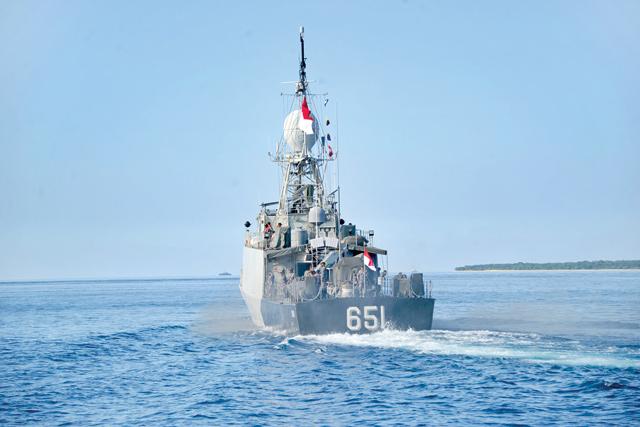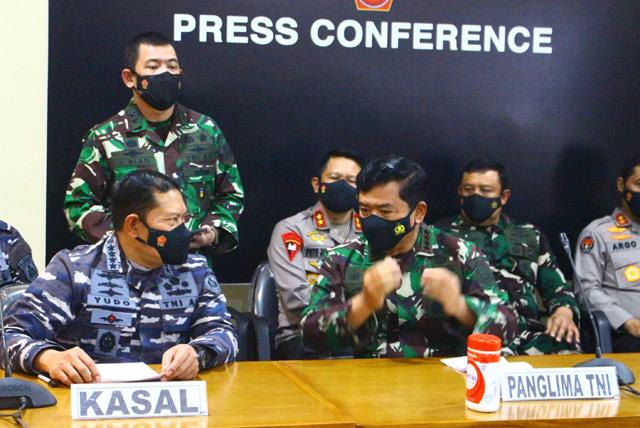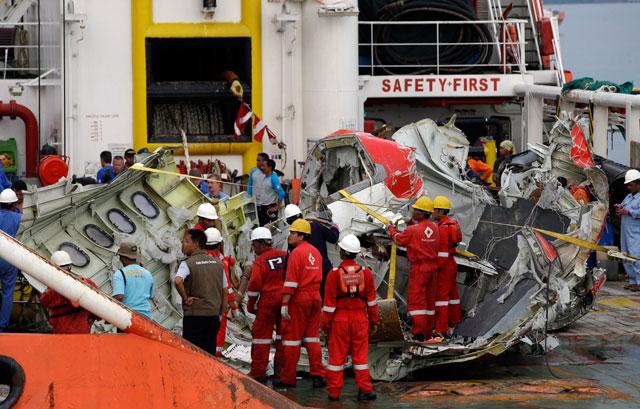You are here
Indonesia military says missing submarine sank with dozens aboard
By AFP - Apr 24,2021 - Last updated at Apr 24,2021

The Indonesian Navy patrol boat KRI Singa (651) leaves the naval base in Banyuwangi, East Java province on Saturday, as the military continues search operations off the coast of Bali for the Navy's KRI Nanggala (402) submarine that went missing April 21 during a training exercise (AFP photo)
BALI, Indonesia — Debris has been recovered from a missing Indonesian submarine, the country's navy said Saturday, suggesting that the stricken vessel could have broken apart after sinking with 53 crew aboard.
The development dashed already slim hopes of rescuing the sailors alive after their oxygen reserves were understood to have run out earlier in the day.
Warships, planes and hundreds of military personnel have been searching for the KRI Nanggala 402 since it disappeared off the coast of Bali early Wednesday.
Authorities earlier said the German-built craft was equipped with enough oxygen for only three days after losing power.
That deadline passed Saturday morning.
The navy's chief Yudo Margono said a search party had recovered fragments from the submarine including items from inside the vessel — pointing to a catastrophic accident.
"We have raised the status from submiss to subsunk," he told reporters, adding that the retrieved items could not have come from another vessel.
"[The items] would not have come outside the submarine if there was no external pressure or without damage to its torpedo launcher."
But he discounted an explosion, saying it was more likely the submarine came apart as it was crushed by water pressure at depths topping 800 metres (2,600 feet) — well below what it was built to withstand.
Sonar did not pick up signals to indicate a blast, he added.
"It was not an explosion because [if it was] everything would be in pieces," Margono said.
"This was a gradual cracking."
Navy officials displayed several items including a piece of the vessel’s torpedo system and a bottle of grease used to lubricate a periscope.
They also found a prayer mat commonly used by Muslims. Indonesia is the world’s most populous Muslim-majority nation.
Margono said the hunt for the submarine — and sailors — would continue, but warned that deep waters made the recovery effort “very risky and difficult”.
“We don’t know about the victims’ condition because we haven’t found any of them. So we can’t speculate,” he said in response to questions about the possibility of survivors.
“But with the [discovery] of these items, you can make your own conclusion.”
The submarine — one of five in Indonesia’s fleet — disappeared early on Wednesday during live torpedo training exercises off the Indonesian holiday island.
An oil spill spotted where the submarine was thought to have submerged pointed to possible fuel-tank damage, fanning fears of a deadly disaster.
The vessel was scheduled to conduct the training exercises when it asked for permission to dive. It lost contact shortly after.
Authorities have not offered possible explanations for the submarine’s sudden disappearance or commented on questions about whether the decades-old vessel was overloaded.
The military has said the submarine, delivered to Indonesia in 1981, was seaworthy.
Neighbouring Singapore and Malaysia, as well as the United States and Australia, were among nations helping in the hunt with nearly two dozen ships deployed to scour a search zone covering about 34 square kilometres.
Australia’s HMAS Ballarat arrived earlier Saturday with a US P-8 Poseidon aircraft.
Singapore’s MV Swift Rescue — a submarine rescue vessel — was also taking part.
Deadly disasters
Indonesia’s military said earlier it had picked up signs of an object with high magnetism at a depth of between 50 and 100 metres, raising hopes of finding the submarine.
But Saturday’s announcement means the southeast Asian archipelago joins a list of countries struck by fatal submarine accidents.
Among the worst was the 2000 sinking of the Kursk, the pride of Russia’s Northern Fleet.
That submarine was on manoeuvres in the Barents Sea when it sank with the loss of all 118 aboard. An inquiry found a torpedo had exploded, detonating all the others.
Most of its crew died instantly but some survived for several days before suffocating.
In 2003, 70 Chinese naval officers and crew were killed, apparently suffocated, in an accident on a Ming-class submarine during exercises in 2003.
Five years later, 20 people were killed by poisonous gas when a fire extinguishing system was accidentally activated on a Russian submarine being tested in the Sea of Japan.
And in 2018, authorities found the wreckage of an Argentine submarine that had gone missing a year earlier with 44 sailors aboard.
Related Articles
BALI, Indonesia — A missing Indonesian submarine has been found cracked apart on the seabed in waters off Bali, the military said Sunday, as
Indonesian divers on Sunday found the crucial black box flight recorders of the AirAsia plane that crashed in the Java Sea a fortnight ago with 162 people aboard, the transport ministry said.
Angry Chinese relatives tried to gatecrash Malaysia’s tightly controlled daily media briefing on the missing plane Wednesday in chaotic scenes underlining the frustrations surrounding the 12-day search.


















